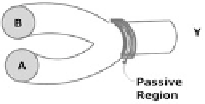Information Technology Reference
In-Depth Information
Simulations suggest that a capacitive termination, such as at a soma, results
in back propagations away from the capacitor. Based on simulations, back
propagations are fairly common, although their existence depends on the
amount of capacitance involved. Back propagation occurs because the capaci-
tance holds charge sufficiently long so as to retrigger the connecting dendrite at
atimewhenithasrecoveredtobetriggered again, sending a propagation back
away from the soma.
At the input tips of a dendrite, there are no reflections, apparently because there
is no extra capacitance. According to simulations pulses simply disappear. So back
propagations do not return again. A similar situation of pulse elimination occurs at
the termination tips of an axon.
Dendritic Logic
The neural gates described next occur in dendrites and are illustrated with dendritic
junctions. Although difficult to visualize, it might be possible for such logic to be
generated without an obvious junction, assuming the equivalent of a junction occurs
because of inhomogeneity in a dendritic segment. Also it might be possible for
close-spaced synapses to produce signals that combine logically in their dendrites,
depending on geometry. However, this is considered dendritic logic since it occurs
in dendrites not in synapses. Several forms of neural logic are possible, but in this
section the focus is on dendritic logic.
Dendritic AND Gate
Excitatory receivers tend to be located toward the tips of the dendrites, whereas
inhibitory receivers tend to be near the soma. This, it turns out, facilitates the
formation of AND gates. Assume that branch Y in Fig.
3.14
is pacified somehow,
possibly by myelination or inhibitory neurotransmitters near the intersection of
branches A and B. Branch A has a voltage pulse v(t)
>
0, while branch B has none,
v(t)
0. Propagation of a voltage pulse from branch A to the output Y is stopped
because of the passive region occurring just after the junction. This occurs because
the incoming pulse is not refreshed in amplitude in the passive region, so voltage is
attenuated to below the triggering threshold as the pulse emerges from the passive
region. A limited charge trickles through toward Y, not enough to trigger the active
portion.
¼
Fig. 3.14
Dendritic AND
gate concept

Search WWH ::

Custom Search